The 14 Best Hedge Plants To Grow For Privacy
Create the privacy you long for without a hefty price tag by planting a “living wall” of shrubs.
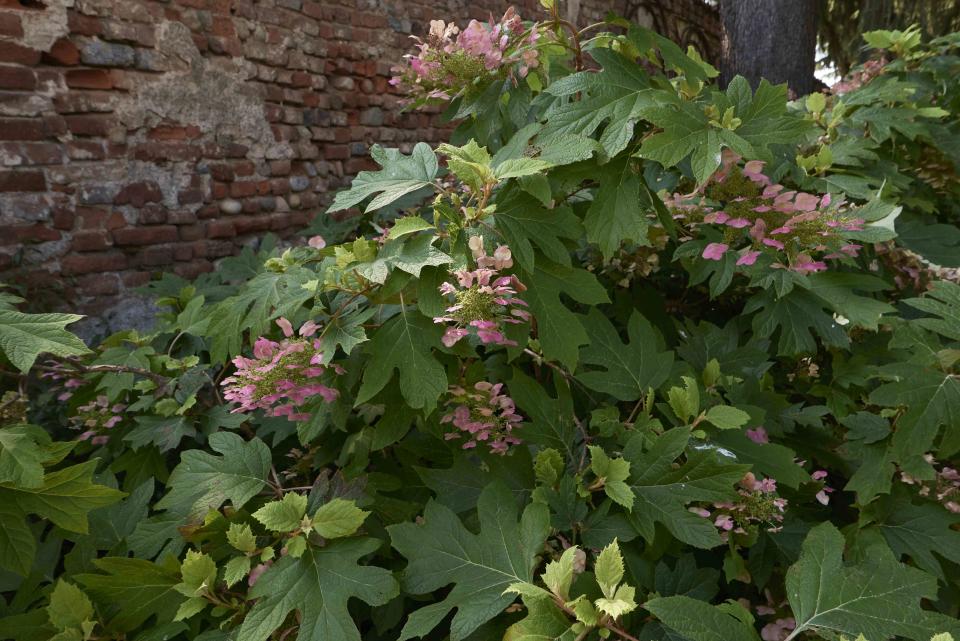
Getty Images /seven75
Good fences may make good neighbors, but let’s face it, fences are not very charming. There’s a better, more attractive solution out there—hedge plants. Hedges are shrubs planted close together to define outdoor spaces, create privacy, shelter garden rooms, and serve as a backdrop to planting beds. They work hard in the landscape while adding color, texture, and structure. Not all shrubs work well as hedges. We’ve rounded up fourteen of the best hedge plants to beautify your garden and give you the privacy you seek.
Factors To Consider When Choosing Hedge Plants
When selecting shrubs to plant as hedges, it is important to consider the desired height. A privacy hedge may need to be quite tall, particularly if your neighbor’s property is uphill for yours. On the other hand, low hedges can be used to define space while still creating a sense of separation. Although many hedges can be pruned to maintain a desired size, it is much easier to start with a variety that naturally grows to the desired height and width, eliminating the need to prune. Also consider the growth rate of hedge plants. Slow-growing species will take longer to create the desired privacy than fast-growing species.
Another factor is the density of foliage on different hedge plants. Hollies and boxwoods have tightly packed leaves that work well at creating dense walls of foliage. Rose of Sharon also makes a good hedge but has a more open canopy. Although many hedge plants are evergreen, several deciduous shrubs can also be used, which will impact winter appearance.
The density at which you plant individual shrubs within a hedge further impacts how complete the sense of enclosure. Space plants closer for a denser screen and wider apart for a more open enclosure. The exact spacing varies according to the species and cultivar being grown, but a handy rule of thumb is to set low-growing hedge plants (3-4 feet tall) about two feet apart within rows. Taller hedge plants can typically be set 3 to 4 feet apart, however, many of the selections on this list were chosen for their narrow stature and will require closer spacing.
Finally, consider whether you wish to maintain a formal, clipped hedge or a more natural one and choose plants accordingly. As with any planting, match plant selections to your local climate including rainfall and summer and winter temperatures. Use plants well within your hardiness zone, as it can be devastating to lose a full-grown hedge to atypical freezes.
Related: 15 Best Foundation Plants For The Front Of Your House
Oakland® Holly
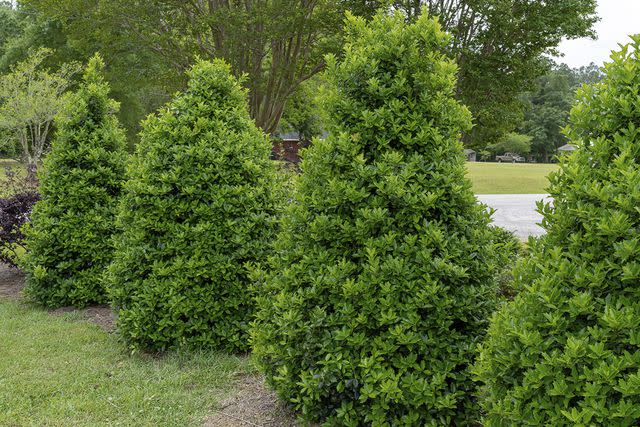
Southern Living Plant Collection
Botanical Name: Ilex hybrid 'Magland'
Sun Exposure: Full Sun to Part Shade
Soil Type: Medium, Well-draining, Rich
Soil pH: Acidic (5.0-6.5)
Mature Size: 15–25′ high x 10–15′ wide
Hollies are among the top choices for privacy hedges thanks to their dense evergreen foliage and adaptability. The Oakland® variety has distinct leaves that are oak shaped. Another great variety is the newly introduced Nelliet™ holly. Nelliet™ has a tight, upright growth habit and very dense foliage, thanks to its shorter internodes (the space between leaves). Plants require little to no pruning to maintain their attractive shape.
Fairy Magnolia®
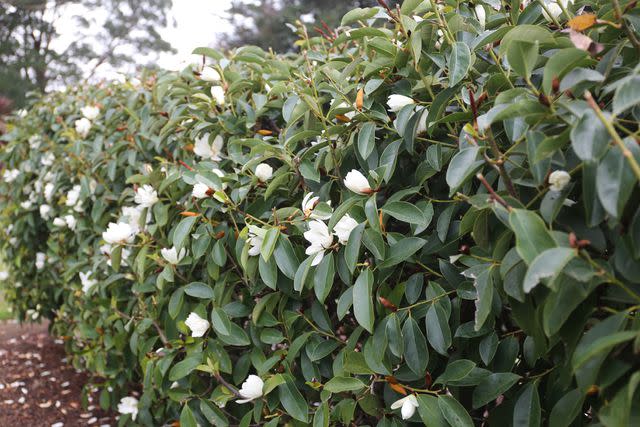
Anthony Tesselaar Plants
Botanical Name: Michelia hybrids
Sun Exposure: Full Sun to Part Shade
Soil Type: Medium, Well-draining, Rich
Soil pH: Acidic to Neutral (5.0-7.0)
Mature Size: 9-12′ high x 5-7′ wide
These bushy magnolias are covered in dark evergreen foliage and produce a profusion of lightly fragrant flowers in spring. They grow quickly to establish a hedge or windbreak. Flowers are available in three colors: blush pink, white, and cream. Set plants three feet apart to create a dense hedge or farther apart for a loose screen. Avoid heavy and poorly draining soil.
Cleyera Bigfoot™
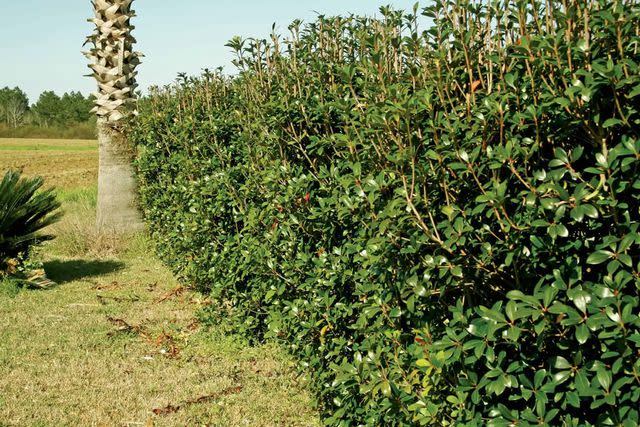
Southern Living Plant Collection
Botanical Name: Ternstroemia gymnanthera 'Sotall'
Sun Exposure: Full Sun to Part Shade
Soil Type: Medium, Well-draining, Rich
Soil pH: Acidic (5.0-6.5)
Mature Size: 15-20′ high x 5-6′ wide
Bigfoot™ is a giant among cultivated cleyeras, soaring at fifteen to twenty feet tall. This fast-growing shrub makes a beautiful hedge with glossy evergreen leaves that grow uniformly head-to-toe. Despite its height, Bigfoot™ has a narrow profile. At just 5 to 6 feet, it can be used in tight spaces that need screening or protection.
Purple Pillar® Rose of Sharon
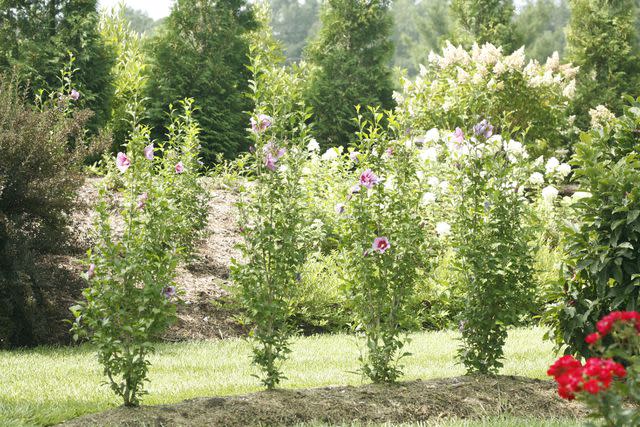
Proven Winners®
Botanical Name: Hibiscus syriacus 'Gandini Santiago'
Sun Exposure: Full Sun
Soil Type: Medium, Well-draining, Average Fertility
Soil pH: Acidic to Slightly Alkaline (5.0-8.0)
Mature Size: 10-16′ high x 4-5′ wide
Purple Pillar® Rose of Sharon is another great hedge plant for narrow spaces. With a slim profile just four to five feet wide, this gorgeous deciduous shrub makes a lovely flowering hedge that blooms summer through fall. Flowers are lilac purple with a red-streaked throat. Heat and drought tolerant once established, this prolific bloomer will draw scores of butterflies, hummingbirds, and bees to the garden.
Camellia
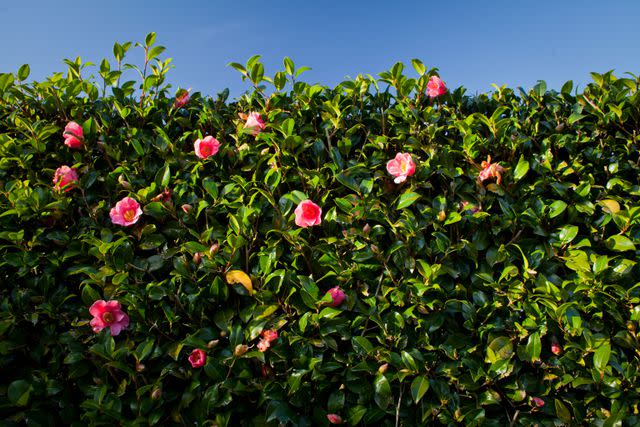
Getty Images / joannatkaczuk
Botanical Name: Camellia species and cultivars
Sun Exposure: Part Shade
Soil Type: Moist, Well-draining, Rich
Soil pH: Acidic (5.5 to 6.5)
Mature Size: 6-12′ high x 5-10′ wide
There are as many camellia varieties as there are gardens to grow them in. Some are more compact than others. Some are bred to tolerate warmer or colder temperatures. All produce gorgeous rose-like blooms. Camellias grow slowly but reward patient gardeners with handsome hedges covered in shiny, deep green foliage year-round and incredible winter blooms. While all the common camellia species make a fine hedge, the species Camellia sasanqua has the advantage of tolerating both full sun and partial shade.
Oakleaf Hydrangea
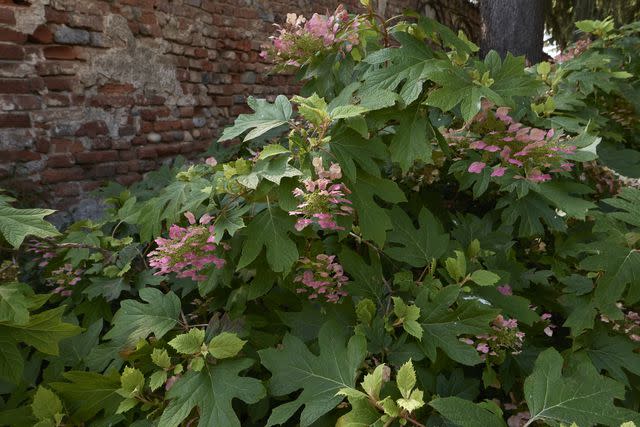
Getty Images /seven75
Botanical Name: Hydrangea quercifolia
Sun Exposure: Full Sun to Part Shade
Soil Type: Medium, Well-draining, Rich
Soil pH: Acidic to Alkaline (5.0 to 8.0)
Mature Size: 6-8′ high x 6-8′ wide
Oakleaf hydrangeas are stately shrubs that make a dramatic hedge with bold, lobed foliage and stunning white to pink blooms. The showy, long-lasting flower heads consist of white flowers packed onto pyramidal panicles that linger well into autumn when the foliage takes on brilliant wine-colored hues. These open-branching shrubs make an informal hedge that requires little pruning.
Red Diamond™ Midsize Loropetalum
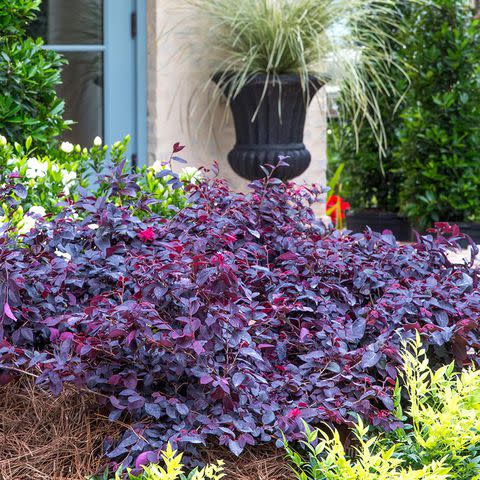
Southern Living Plant Collection
Botanical Name: Loropetalum chinense 'Shang-Red'
Sun Exposure: Full Sun to Part Shade
Soil Type: Medium, Well-draining, Rich
Soil pH: Acidic to Neutral (4.5-7.0)
Mature Size: 6′ high x 6′ wide
Who says hedges must be green? With rich burgundy foliage and vibrant spring blooms, Red Diamond™ loropetalum packs a lot of punch. And because it grows more compact than traditional loropetalums, it won't take over the garden. The gorgeous foliage of Red Diamond™ provides year-round color accented by rosy-red blooms in late winter to early spring.
Oleander
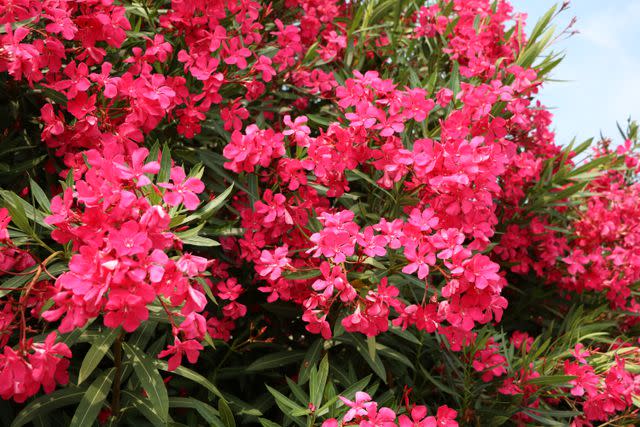
Getty Images / ClaraNila
Botanical Name: Nerium oleander
Sun Exposure: Full Sun
Soil Type: Moist, Well-draining, Rich
Soil pH: Acidic to Alkaline (5.0 and 8.0)
Mature Size: 6-18′ high x 6-10′ wide
This Mediterranean beauty is dressed in lovely willow-like foliage and sprays of red, pink, or white blooms all summer long. With an upright growth habit and loose, open canopy, oleander makes a graceful evergreen hedge in warmer areas where it is winter hardy, zones 8B and warmer. Plants are heat and drought tolerant once established, and grow well in coastal gardens, tolerating salt spray and wind. Oleander looks best when left untrimmed to take on its natural form. Compact cultivars are available.
'Spartan' Chinese Juniper
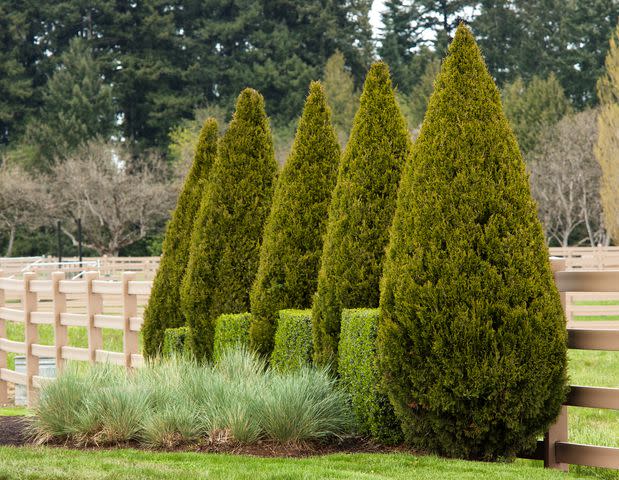
Monrovia.com by Doreen Wynja
Botanical Name: Juniperus chinensis 'Spartan'
Sun Exposure: Full Sun
Soil Type: Medium, Well-draining, Average Fertility
Soil pH: Acidic to Alkaline (5.0 and 8.0)
Mature Size: 15′ high x 3-5′ wide
With an excellent pyramidal form and narrow habit, this handsome evergreen makes a dense windbreak or privacy screen in the tightest of spaces. 'Spartan' grows quickly and is a great problem solver for difficult areas, tolerating heat, drought, air pollution, and dry soils. This tough, adaptable evergreen requires no pruning or pampering.
Forever Goldy® Arborvitae
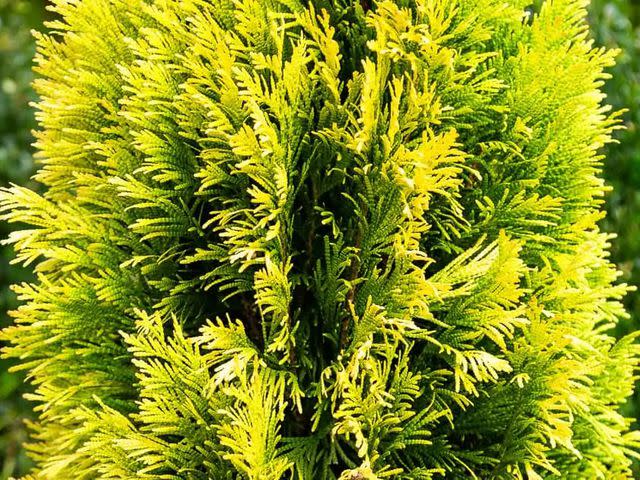
Southern Living Plant Collection
Botanical Name: Thuja plicata '4EVER'
Sun Exposure: Full Sun to Part Shade
Soil Type: Moist, Well-draining, Rich
Soil pH: Acidic to Neutral (5.0-7.0)
Mature Size: 15-20′ high x 6-8′ wide
The Forever Goldy® Arborvitae provides year-round foliage and privacy, even during the heat and full sun of Southern summers. Provide consistent irrigation to support new growth. Arborvitae are also great for landscapes where deer are a problem. The newer Arborvitae 'Green Valley' is also a great variety which offers higher heat tolerance, and disease resistance. Green Valley™ Arborvitae grows around one foot each year, quickly transforming your landscape into a private oasis.
Bright 'N Tight™ Carolina Laurel
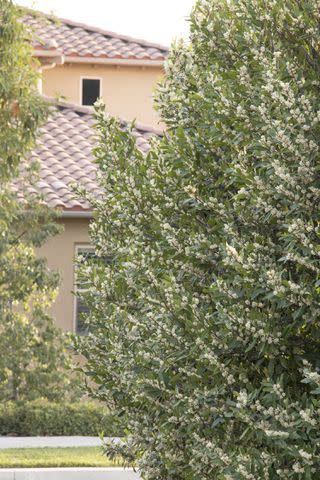
Monrovia.com by Doreen Wynja
Botanical Name: Prunus caroliniana 'Monus'
Sun Exposure: Full Sun to Part Shade
Soil Type: Moist, Well-draining, Rich
Soil pH: Acidic to Slightly Alkaline (5.5-8.0)
Mature Size: 8-10′ high x 6-8′ wide
Native plant enthusiasts searching for an evergreen native hedge plant will adore Bright 'N Tight™ Carolina cherry laurel. With glossy green foliage and showy, fragrant spring blooms, Bright 'N Tight™ is a smaller, more compact version of the species. Perfect for windbreaks, screening, and hedges, this tree also supports an abundance of birds. Robins and cedar waxwings feast on the blue-black berries in winter and early spring. Carolina cherry laurel is moderately salt tolerant and performs well in coastal landscapes.
Majestic Beauty® Indian Hawthorn
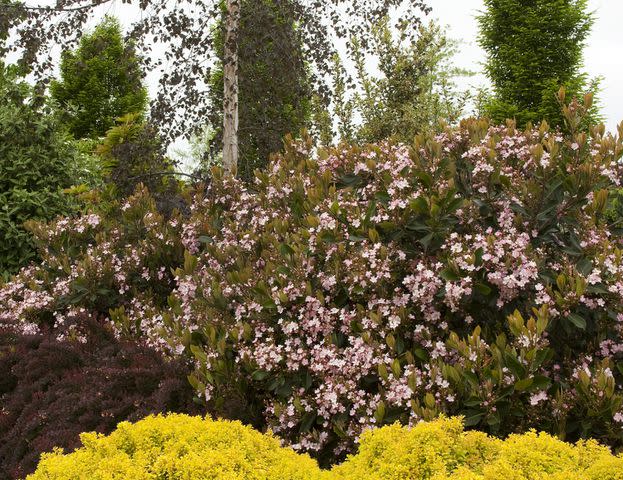
Monrovia Bright 'N Tight⢠Carolina Laurel
Botanical Name: Rhaphiolepis hybrid 'Montic'
Sun Exposure: Full Sun to Part Shade
Soil Type: Medium, Well-draining, Average Fertility
Soil pH: Moderately Acidic to Slightly Alkaline (6.0 to 7.5)
Mature Size: 10-12′ high x 8-10′ wide
A waterwise shrub for naturalistic screens and hedges, Majestic Beauty® is an improved Indian hawthorn selection with better pest resistance. Thick evergreen foliage and fragrant pink blooms provide beauty throughout the seasons. Pollinators frequent the showy blooms while songbirds are attracted to the autumn fruits. Resistant to salt, drought, and wind, Indian hawthorn is a useful coastal hedge plant.
Mood Ring® Podocarpus
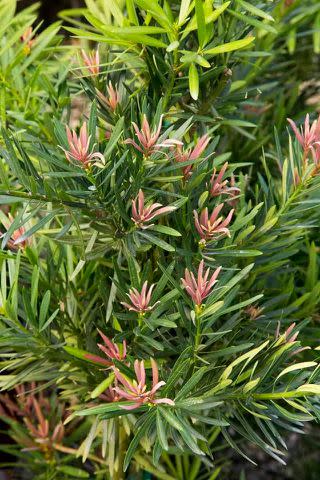
Southern Living Plant Collection
Botanical Name: Podocarpus macrophyllus 'Sosa'
Sun Exposure: Full Sun to Part Shade
Soil Type: Moist, Well-draining, Rich
Soil pH: Acidic to Neutral (4.5-7.0)
Mature Size: 10-15′ high x 3-4′ wide
With a slender profile and dense evergreen foliage, Mood Ring® Podocarpus brings upright structure and year-round color to any sized landscape. New growth emerges with a lovely bronze-pink color in spring before turning deep green. This tough, low-maintenance shrub tolerates salt, drought, and heat, and resists deer browsing.
Sweet Viburnum
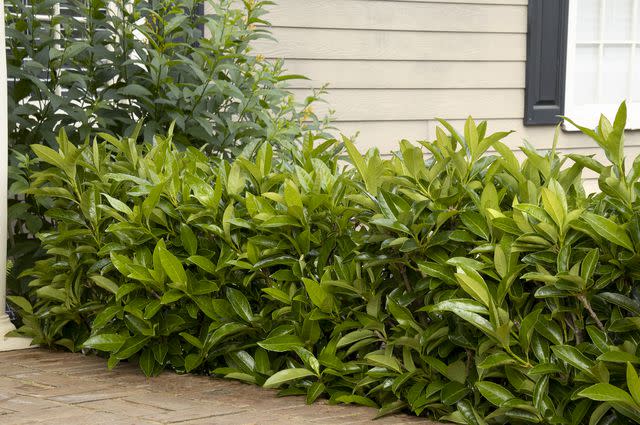
Monrovia.com by Doreen Wynja
Botanical Name: Viburnum awabuki 'Chindo'
Sun Exposure: Full Sun to Part Shade
Soil Type: Medium to Moist, Well-draining, Rich
Soil pH: Slightly Acidic (5.5-6.5)
Mature Size: 10-12′ high x 6-8′ wide
This handsome broadleaf evergreen is great for wildlife enthusiasts, with fragrant white blooms and showy berries that ripen from red to black in autumn. Pollinators and songbirds are frequent visitors. Sweet viburnum adapts to a wide range of soil conditions and grows quickly to create a privacy screen. Plants resist deer and drought.
For more Southern Living news, make sure to sign up for our newsletter!
Read the original article on Southern Living.

